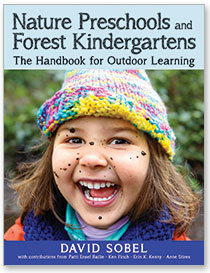![[Wild Child] cover](https://depts.washington.edu/hortlib/graphix/wildchild300.jpg)
Patrick Barkham’s Wild Child: Coming Home to Nature chronicles his year as a parent volunteer at the his children’s forest school, interwoven with memories of his own childhood and musings on the role of nature in our lives, especially while we are young. Childhood has changed since Barkham’s youth in 1980s Norfolk (UK), when he and neighboring kids roamed every day, inventing outdoor diversions. Most parents today feel a responsibility to provide constant supervision, or at least keep kids in out of the weather. Something has been lost, Barkham believes, and enrolling his three children at Dandelion outdoor nursery helps to restore it, grounding them in the natural world around them. As he says, “Formative experiences resonate throughout our lives.”
For me, one of the highlights of this book was the opportunity to learn new words and new usages. Some, like “reception year” (which refers to the first year of primary school), “clodgy,” “gubber,” and “slub” (all words for mud), and “sallow” (another word for the pussywillow tree), are new words for known concepts. Others are novel concepts for me. Soft fascination, which describes the power of forests and other natural environments to keep our senses gently engaged without wearing out our attention spans or tiring us, was a revelation to me. Coined by environmental psychologists Rachel and Stephen Kaplan in 1989, soft fascination is a hallmark of restorative environments, distinct from a state of “directed attention” such as listening to a lecture or watching TV. Environments rich in soft fascination help to recharge us, making them ideal for learning. Some educators in the UK have taken advantage of this fact by offering some outdoor lessons to upper primary school students who struggle in the classroom. The author is impressed with what he learns visiting two of these outdoor experience programs. In one forest school program for English language learners, many of them refugees, students who participated had improved test scores and attendance as well as harder-to-quantify improvements in confidence and attentiveness.
As an appendix, Barkham provides plenty of fresh ideas for outdoor engagement, including hapa-zome (a Japanese method of transferring leaf colors and patterns to fabric with a hammer) and seaweed cyanotypes. He reminds parents and teachers that it’s not knowledge but love of nature we need to impart. Young people will gather their own knowledge, once they have a chance to get outdoor experiences.
Published in the November 2020 Leaflet for Scholars, Volume 7, Issue 11.
![[The Outdoor Classroom in Practice, Ages 3-7] cover](https://depts.washington.edu/hortlib/graphix/outdoorclassroominpractice.jpg)
![[Ecological Literacy] cover](https://depts.washington.edu/hortlib/graphix/ecologicalliteracy.jpg)
 Reading David Sobel’s latest book feels like attending a national conference on outdoor early childhood education. Each chapter draws on the expertise and experience of key decision-makers working with young children in nature programs all over the country. The format also gives a sense of history and progress over time, with Sobel’s journal entries from his work in outdoor education in the 1970s and his personal parenting journals from the 1990s presented alongside his contemporary research and observations from visits to today’s outdoor preschools.
Reading David Sobel’s latest book feels like attending a national conference on outdoor early childhood education. Each chapter draws on the expertise and experience of key decision-makers working with young children in nature programs all over the country. The format also gives a sense of history and progress over time, with Sobel’s journal entries from his work in outdoor education in the 1970s and his personal parenting journals from the 1990s presented alongside his contemporary research and observations from visits to today’s outdoor preschools.